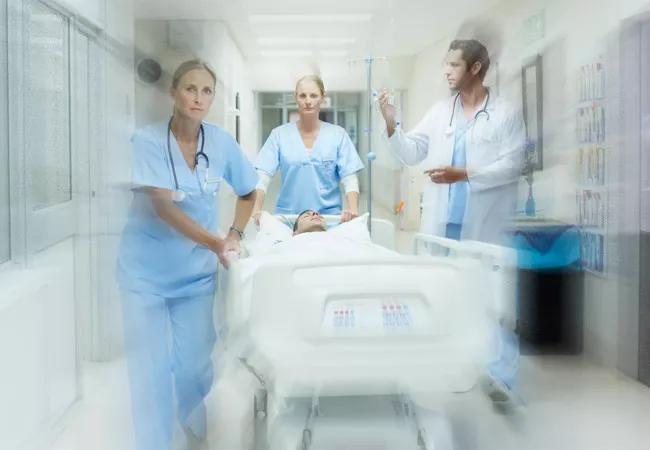CSCs achieve timelier acute reperfusion therapy, national study finds

Do Comprehensive Stroke Centers really offer an advantage over Primary Stroke Centers in providing patient care?
Advertisement
Cleveland Clinic is a non-profit academic medical center. Advertising on our site helps support our mission. We do not endorse non-Cleveland Clinic products or services. Policy
According to a large new national study of stroke centers, the answer is yes, at least on a few key measures, although overall stroke care was found to be broadly similar between the two certification levels. The study was presented at the 2018 International Stroke Conference in Los Angeles. (Editor’s note: The full study was published online by Circulation: Cardiovascular Quality and Outcomes on May 23, 2018.)
“Determining whether Comprehensive Stroke Centers offer an advantage and, if so, how much of one, is important for allocating resources to optimize patient care,” says Ken Uchino, MD, Director of Research and Education for Cleveland Clinic’s Cerebrovascular Center and a co-author of the multicenter study. “Does every community need a Comprehensive Stroke Center? Does every patient with an acute stroke need to be referred to one? Such questions are worth investigating.”
To briefly define terms, The Joint Commission provides certification to hospitals that meet standards recommended by the Brain Attack Coalition for care of acute stroke. Since 2012, two levels of certification have been offered: Primary Stroke Centers (PSCs) and Comprehensive Stroke Centers (CSCs), with the latter designation requiring an ability to provide more-complex services, including 24/7 availability of endovascular procedures.
Investigators with the current study used the American Heart Association/American Stroke Association’s Get With The Guidelines®–Stroke database to identify consecutive patients with a final diagnosis of acute ischemic stroke who were admitted to 134 CSCs (110,624 patients) and 1,047 PSCs (494,512 patients) between January 1, 2013, and December 31, 2015.
Advertisement
Multivariable regression analysis was done to explore associations between facilities’ certification level and performance measures and outcomes, after adjustment for potential confounding variables.
CSCs were noted to be larger than PSCs, with median bed counts of 481 versus 263, respectively.
Almost all hospitals in both groups (94 percent) were found to conform with seven key performance measures, including intravenous thrombolysis among those arriving within two hours of symptom onset; use of antithrombotic medication and deep vein thrombosis prophylaxis in appropriate patients; discharge medications for atrial fibrillation and lipid lowering when indicated; and addressing smoking cessation.
However, CSCs outperformed PSCs in several key measures, especially in the use of intravenous tissue plasminogen activator (IV tPA) and intra-arterial thrombectomy (IA therapy). Among the significant differences:
Advertisement
“We observed that CSCs are slightly but significantly better at providing prompt acute treatment,” says Dr. Uchino. “But overall, stroke care is similar between CSCs and PSCs, and both types of facilities are achieving good quality process measures.”
Dr. Uchino notes that there are many complexities in doing a study such as this one. Some PSCs are actually equivalent to CSCs but for various reasons have not pursued the higher certification. Others may provide thrombectomy (one of the key differences between the certification levels) but are missing other elements believed to be less critical. Such issues potentially confound the data by blurring differences between the two types of facilities.
Interestingly, the study found that in-hospital mortality was modestly higher at CSCs than at PSCs, even after adjusting for patient comorbidities (4.6 percent versus 3.8 percent; adjusted OR = 1.14; 95% CI, 1.01-1.29). According to Dr. Uchino, the current study cannot account for this difference, and he suspects other unmeasured variables may offer an explanation since it’s unlikely that the higher level of care measures at CSCs found in the study led to more deaths.
“It is critical for facilities to be transparent about their outcomes by collecting data on their performance measures and making them available for investigation and comparison,” he adds. “This is the only way we can determine if initiatives such as acute stroke care certification are important and how to further improve patient outcomes.”
Advertisement
Cleveland Clinic’s main campus hospital is a Joint Commission-certified Comprehensive Stroke Center. Cleveland Clinic health system also includes seven Primary Stroke Centers.
Advertisement
Advertisement

Dopamine agonist performs in patients with early stage and advanced disease

Validated scale provides a method for understanding how lifestyle may protect against Alzheimer's

Promising preclinical research indicates functional motor recovery is durable

A principal investigator of the landmark longitudinal study shares interesting observations to date

Cleveland Clinic researchers collaborate with Microsoft to create a product ready for the field

Understanding TE involvement is a key to developing new treatments

Study aims to inform an enhanced approach to exercise as medicine

$3.2 million grant will fund use of calcium-based imaging to record neuronal activity in ischemia model